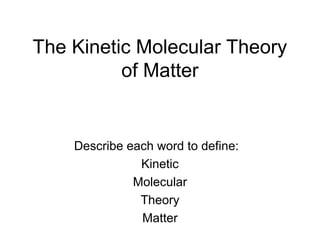
The kinetic molecular theory of matter
- 1. The Kinetic Molecular Theory of Matter Describe each word to define: Kinetic Molecular Theory Matter
- 2. THEREFORE ALL MATTER __________!!!
- 3. • The Kinetic Molecular Theory of Matter states that the particles in all matter are in a constant state of motion. • The theory is used to explain the properties of solids, liquids and gases.
- 4. Five Assumptions of the Kinetic Molecular Theory 1. Gases consist of large numbers of tiny particles that are far apart relative to their size. - Most of the volume occupied by a gas is empty space. - Accounts for lower density compared to solid and liquids.
- 5. 2. Collisions between gas particles and between particles and container walls are elastic collisions with NO loss of energy.
- 6. 3. Gas particles are in constant, rapid, random motion— They possess KINETIC ENERGY.
- 7. 4. There are no forces of attraction or repulsion between gas particles. Think of ideal gas molecules as behaving like small billiard balls. When they collide, they do not stick together but immediately bounce apart.
- 8. 5. The average kinetic energy of gas particles depends on the temperature of the gas. KE = ½ MV 2 M= mass V= velocity
- 9. All gases at the same temperature have the same average kinetic energy. Therefore, at the same temperature, lighter gas particles, such as hydrogen molecules, have higher average speeds than do heavier gas particles, such as oxygen molecules. The average Kinetic Energy of gas particles depends on Temperature of the gas
- 10. The Kinetic Molecular Theory and the Nature of Gases The kinetic molecular theory applies only to ideal gases. Although ideal gases do not actually exist, many gases behave nearly ideally if pressure is not very high or temperature is not very low. The theory accounts for the physical properties of gases.
- 11. Physical Properties of Gases Expansion - Gases do not have a definite shape. - Gases do not have a definite volume. - They expand to take the shape of their container because they are in rapid, random, constant motion.
- 12. Fluidity - Because the attractive forces between gas particles are slight, gas particles glide past one another. - They flow just like liquids.
- 13. Low Density The density of a substance in the gaseous state is about 1/1000 the density of the same substance in the liquid or solid state. That is because their particles are so spread out and far apart from each other.
- 14. Compressibility -In compression, gas particles are pressed close together. - This greatly decreases the volume making transport much easier
- 15. Diffusion and Effusion Diffusion is the mixing of particles of two substances caused by their random motion. Effusion is the process by which gas particles under pressure pass through a tiny opening.
